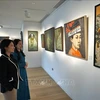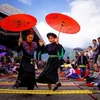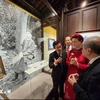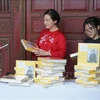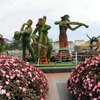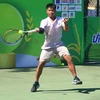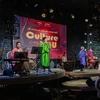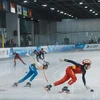At an exhibition of Southeast Asian artists in Hanoi, visitors are invited to be part of the performance. Singaporean artist Amanda Heng's Let's Chat asks the audience to sit down for a chat with the artist, in effect becoming a performer in the artwork.
The exhibition – Concept, Context, Contestation - organised by three curators from Singapore, Indonesia and Thailand, includes work from across the SE Asian region over the last 40 years.
The diverse showing includes performance art, interactive installations, paintings, photography and sound installations from 14 artists, demonstrating the region's artistic and cultural development for good, and for bad.
At Heng's Let's Chat piece, visitors sat at a round table and cleaned bean sprouts. The simple act gave people the chance to talk to each other, face to face.
"Modernisation and urbanisation changed my old village completely in a short time," Heng said.
"In the 1990s, it was easy to see villagers gather, talk, play, joke, share problems and work together. But now, they don't.
"For young people who have jobs in big cities, they may not realise the difference, but for old people like my mother and her neighbours, who live in villages, they feel the change clearly," she said.
Heng said the way people communicate has changed, modernised and lost its personal connection. Even though Heng doesn't speak Vietnamese and visitors don't speak her language, they still create a community around the table.
The exhibition was first held at the Bangkok Art and Culture Centre (BACC) last year. The BACC then co-operated with the Goethe Institute to organise bringing the interactive event to Hanoi.
The curators hope that visitors will not just passively enjoy the artworks, but actively work to understand them and even disagree with them.
"You will see several pieces that invite the audience to interact with the works, not as a gimmick, but as a way of involving the public in the ideas that they advance," said curator Iola Lenzi.
"Indeed, some pieces do not function unless the audience interacts with it, activating it through participation," she said.
Chatvichai Promadhattavedi, board member and secretary of the BACC, emphasised the importance of critical thinking from both artists and audience.
This approach is important for defining Southeast Asian contemporary art that has developed over several generations and across the region.
"Through contests and discussions, our values are redefined," Chatvichai said. "Societies where dialogues and exchange happens amongst their citizens are the winning ones."
"Without differing opinions and alternatives, a society is all the poorer in moving forward. In the context of Southeast Asia, we live in a hugely vibrant region of the world. Cultural redefining that keeps in step with progress is the way forward for our common and sustained prosperity," he said.
At the exhibition, curator Lenzi chaired an art talk on June 18 in which regional artists discussed the exhibition's concept and ways to initiate similar exhibitions in Southeast Asia.
Art journalist Dao Mai Trang, one of the panelists, agreed with Chatvichai. She said both sympathy and opposition to artwork makes artists and audience think and change their minds.
"Critical thinking is encouraged," she said, "different opinions on an issue create diversity in the society. I believe that a diverse society develops sustainably."
Trang suggested, "Like Heng of Singapore, Vietnamese artists should be more open to clearing away the audience's shyness and hesitation, and lure them to approach the artwork and express their opinion."
The exhibition will run until the end of the month at the Goethe Institute, 56-58 Nguyen Thai Hoc street, Hanoi.-VNA
The exhibition – Concept, Context, Contestation - organised by three curators from Singapore, Indonesia and Thailand, includes work from across the SE Asian region over the last 40 years.
The diverse showing includes performance art, interactive installations, paintings, photography and sound installations from 14 artists, demonstrating the region's artistic and cultural development for good, and for bad.
At Heng's Let's Chat piece, visitors sat at a round table and cleaned bean sprouts. The simple act gave people the chance to talk to each other, face to face.
"Modernisation and urbanisation changed my old village completely in a short time," Heng said.
"In the 1990s, it was easy to see villagers gather, talk, play, joke, share problems and work together. But now, they don't.
"For young people who have jobs in big cities, they may not realise the difference, but for old people like my mother and her neighbours, who live in villages, they feel the change clearly," she said.
Heng said the way people communicate has changed, modernised and lost its personal connection. Even though Heng doesn't speak Vietnamese and visitors don't speak her language, they still create a community around the table.
The exhibition was first held at the Bangkok Art and Culture Centre (BACC) last year. The BACC then co-operated with the Goethe Institute to organise bringing the interactive event to Hanoi.
The curators hope that visitors will not just passively enjoy the artworks, but actively work to understand them and even disagree with them.
"You will see several pieces that invite the audience to interact with the works, not as a gimmick, but as a way of involving the public in the ideas that they advance," said curator Iola Lenzi.
"Indeed, some pieces do not function unless the audience interacts with it, activating it through participation," she said.
Chatvichai Promadhattavedi, board member and secretary of the BACC, emphasised the importance of critical thinking from both artists and audience.
This approach is important for defining Southeast Asian contemporary art that has developed over several generations and across the region.
"Through contests and discussions, our values are redefined," Chatvichai said. "Societies where dialogues and exchange happens amongst their citizens are the winning ones."
"Without differing opinions and alternatives, a society is all the poorer in moving forward. In the context of Southeast Asia, we live in a hugely vibrant region of the world. Cultural redefining that keeps in step with progress is the way forward for our common and sustained prosperity," he said.
At the exhibition, curator Lenzi chaired an art talk on June 18 in which regional artists discussed the exhibition's concept and ways to initiate similar exhibitions in Southeast Asia.
Art journalist Dao Mai Trang, one of the panelists, agreed with Chatvichai. She said both sympathy and opposition to artwork makes artists and audience think and change their minds.
"Critical thinking is encouraged," she said, "different opinions on an issue create diversity in the society. I believe that a diverse society develops sustainably."
Trang suggested, "Like Heng of Singapore, Vietnamese artists should be more open to clearing away the audience's shyness and hesitation, and lure them to approach the artwork and express their opinion."
The exhibition will run until the end of the month at the Goethe Institute, 56-58 Nguyen Thai Hoc street, Hanoi.-VNA



